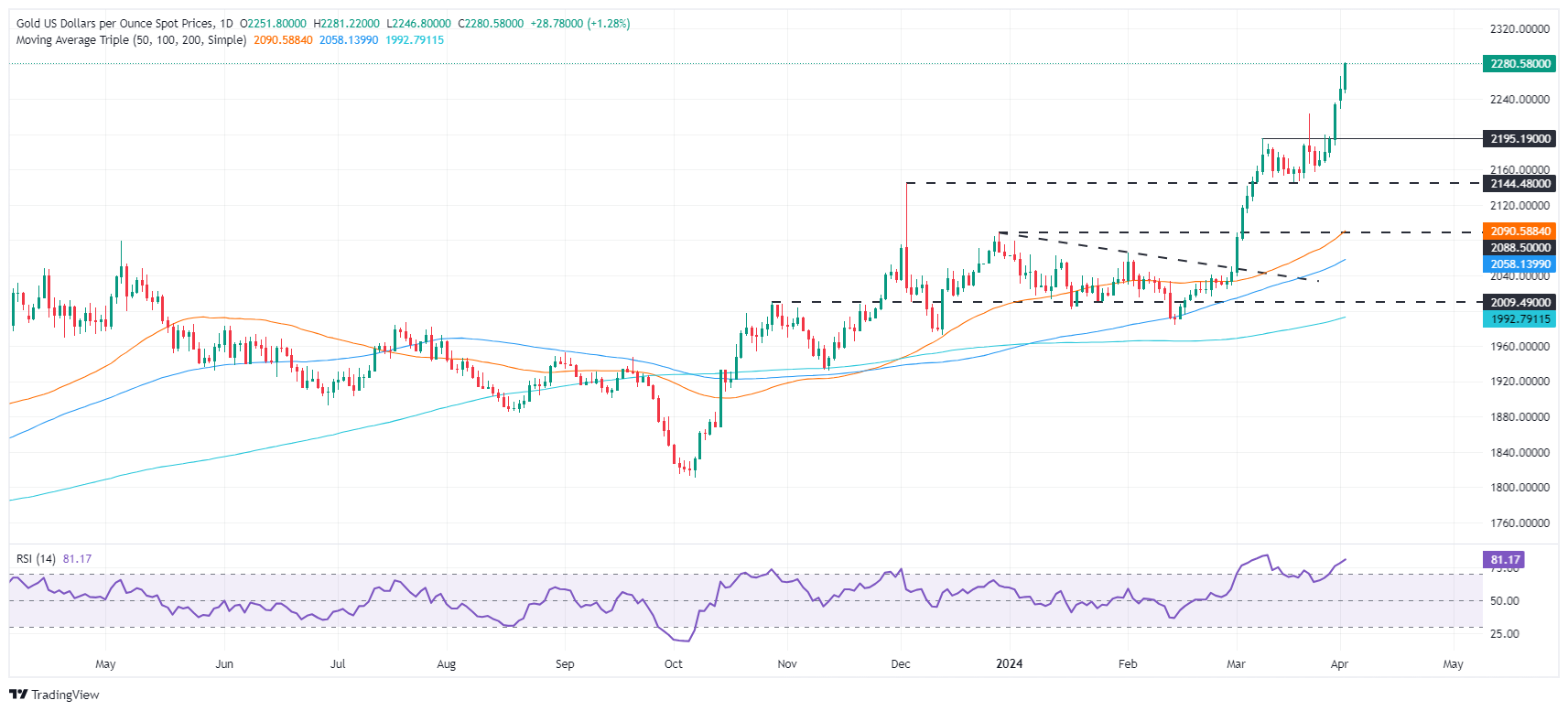Gold hits all-time record high amid geopolitical tensions, higher US yields
- Gold climbs to $2,280, driven by Middle East tensions, strong US data.
- High US Treasury yields, strong US Dollar counterbalanced by geopolitical worries, tight labor market.
- Mester lacks info for a May cut but predicts three 2024 cuts, balancing inflation and job risks.
- Daly discusses rate duration, supports three cuts as a projection, not a promise.
Gold price rallies to new all-time highs of $2,276 late in the North American session amid geopolitical risks and despite higher US Treasury yields. Economic data from the United States (US) prompted investors a flight to safe-haven assets, sending the yellow metal higher. At the time of writing XAU/USD exchanges hands at $2,280 gaining more than 1%.
The recent attack of Israel against an Iran embassy in Syria on April 1, sponsored Gold’s leg up despite witnessing a jump I US yields and a strong US Dollar on Monday. Aside from this, the US Bureau of Labor Statistics (BLS) showed that job vacancies increased, revealing a tight labor market, while the US Census Bureau witnessed an improvement in Factory Orders.
In the meantime, Federal Reserve (Fed) officials crossed the newswires, led by the Cleveland Fed President Loretta Mester and the San Francisco Fed President Mary Daly.
Daily digest market movers: Gold price ignores goodish US data, high US yields
- February’s Job Openings and Labor Turnover (JOLTS) summary revealed that job vacancies remained relatively stable. The figures reached 8.756 million, slightly above the previous month's revised total of 8.748 million and just surpassing the expected 8.75 million.
- Factory Orders in February experienced a growth of 1.4%, recovered from a -3.4% decline in January and exceeded the forecasts of a 1% increase.
- Cleveland Fed Loretta Mester said that she doesn’t have enough information for a May meeting cut, yet foresees three rate cuts in 2024. Mester added the Fed’s challenge would be balancing the risks between inflation and employment.
- San Francisco Fed President Mary Daly said the Fed need to see how long to keep rates at current levels. She supports three rate cuts, but added that it’s a projection, not a promise.
- On Friday, Fed Chair Jerome Powell responded to the latest inflation data, stating it aligned with their expectations and indicating that the Fed would not overreact to these figures. This suggests that the US central bank would remain in a wait-and-see approach toward future monetary policy decisions.
- In terms of the Federal Reserve's future interest rate movements, the CME FedWatch Tool indicates that traders currently assign a 58% likelihood to the prospect of the US central bank reducing borrowing costs.
Technical analysis: Gold rally extends, despite RSI’s being overbought
The XAU/USD daily chart suggests the yellow metal is headed towards the $2,300 figure amid renewed buying pressures observed in the Relative Strength Index (RSI). On Monday, I mentioned that “The XAU/USD daily chart depicts Gold's last uptick to new all-time highs, achieved on lower momentum, as depicted by the Relative Strength Index (RSI).” However, as of writing, the RSI has punched above the 80.00 threshold, an indications that buyers are in charge.
With price action at uncharted territory, the next resistance level would be the $2,300 mark, followed by the $2,350 psychological figure. Up next would be $2,400.
On the other hand, if XAU/USD drops below $2,250, that could sponsor a correction. The first support would be the $2,200 figure, followed by the March 8 high turned support at $2,195, ahead of extending its losses to $2,150.
Gold FAQs
Gold has played a key role in human’s history as it has been widely used as a store of value and medium of exchange. Currently, apart from its shine and usage for jewelry, the precious metal is widely seen as a safe-haven asset, meaning that it is considered a good investment during turbulent times. Gold is also widely seen as a hedge against inflation and against depreciating currencies as it doesn’t rely on any specific issuer or government.
Central banks are the biggest Gold holders. In their aim to support their currencies in turbulent times, central banks tend to diversify their reserves and buy Gold to improve the perceived strength of the economy and the currency. High Gold reserves can be a source of trust for a country’s solvency. Central banks added 1,136 tonnes of Gold worth around $70 billion to their reserves in 2022, according to data from the World Gold Council. This is the highest yearly purchase since records began. Central banks from emerging economies such as China, India and Turkey are quickly increasing their Gold reserves.
Gold has an inverse correlation with the US Dollar and US Treasuries, which are both major reserve and safe-haven assets. When the Dollar depreciates, Gold tends to rise, enabling investors and central banks to diversify their assets in turbulent times. Gold is also inversely correlated with risk assets. A rally in the stock market tends to weaken Gold price, while sell-offs in riskier markets tend to favor the precious metal.
The price can move due to a wide range of factors. Geopolitical instability or fears of a deep recession can quickly make Gold price escalate due to its safe-haven status. As a yield-less asset, Gold tends to rise with lower interest rates, while higher cost of money usually weighs down on the yellow metal. Still, most moves depend on how the US Dollar (USD) behaves as the asset is priced in dollars (XAU/USD). A strong Dollar tends to keep the price of Gold controlled, whereas a weaker Dollar is likely to push Gold prices up.







